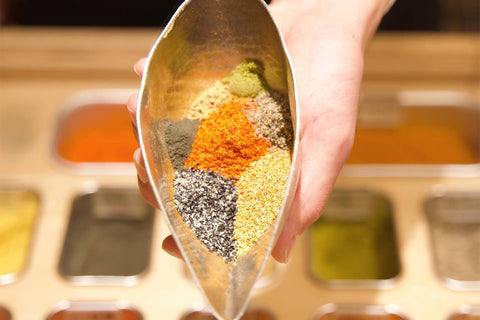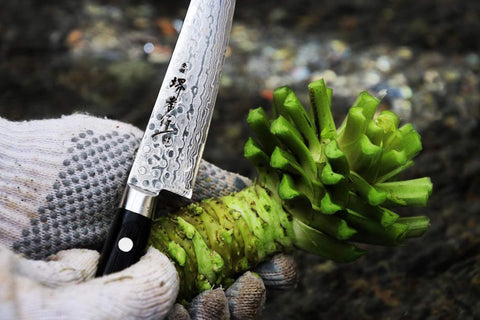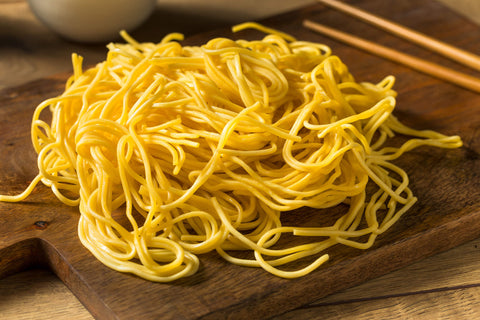
Like most national cuisines, Japanese cooking has its own unique flavours that make it so popular. Finding the spices and seasonings required to duplicate these tastes in a Western kitchen used to be difficult, with many of the key ingredients being almost impossible to obtain over here, and the homegrown alternatives failing to produce the same subtlety of flavour.
Fortunately, the growth in popularity of Japanese cooking has led to increased availability of some of the nation’s most popular and important herbs, spices, and seasonings. At SushiSushi, we always recommend using the genuine article from Japan, rather than Western substitutes, so you can get the full taste experience.
Japanese Spices
Japanese chefs tend to use few dried spices and herbs, preferring to cook with fresh herbs, pastes, and liquid condiments. There are, however, a few native Japanese spices that belong in any well-stocked kitchen. These are some of the most useful ones…
Sansho Pepper
Kona-zanshō is a floral, fragrant & citrusy pleasant seasoning with a numbing sensation that is produced from the dried fruit of the Japanese pepper shrub (zanthoxylum piperitu). It is similar in flavour and application to Szechuan pepper which come from the same genus of plant. The peppercorns are dried and crushed, producing a distinctive green pepper spice that is used to season a range of dishes, including kabayaki-unagi (broiled eel). Sansho pepper is also one of several components of the traditional shichimi mix.
Wasabi
Wasabi is a member of the horseradish family, cultivated almost exclusively in Japan. It has a pungent aroma and a powerful kick of heat that makes it a popular condiment for sushi dishes. Traditionally layered between the fish and the rice, many modern sushi chefs have started serving wasabi as a side dish, as this is the popular way of using it in Western sushi culture.
Furikake
Furikake is a common seasoning in Japan, often sprinkled over cooked rice, vegetables, and fish to add flavour to a dish. There is no specific set of ingredients for making furikake, though most varieties include a mix of sesame seeds, dried fish, sugar, salt, seaweed, and monosodium glutamate, giving the seasoning a nice, umami taste. Some manufacturers include bonito flakes, shiso, egg, or miso into their mix to add their own flavour notes.
Matcha
Matcha is a finely-ground powder derived from green tea leaves. The tea plants used in the production of matcha are specially grown in the shade for several weeks prior to harvest, resulting in higher levels of caffeine and theanine than traditional tea. The matcha powder can be served suspended in milk or water, or can be used to flavour a variety of dishes. It has a creamy, sweet taste, making it a popular addition to ice cream, sweets, cakes, and confectionary.
Ginger
Ginger is a flowering plant, the root of which is used as a spice and flavouring in many cuisines, including Japanese. It provides heat and sweetness and can be found in both sweet and savoury dishes. Fresh ginger is preferred when prepared hot meals and can be added sliced, chopped, or grated. For cakes and confectionery, powdered ginger is more commonly used. Pickled ginger – or gari – is a popular condiment served on the side of sushi dishes, where it acts as a palate cleanser.
Sesame
Whether using the oil, the whole seeds, or ground, roasted gomashio, sesame is one of the most popular flavours in Japanese cooking. Sesame seeds come in black and white varieties and can be mixed into soups and stews during cooking, where they release their natural oils and flavours, or sprinkled cold over food to add flavour and texture. Toasted sesame seeds are a popular choice for this, as the toasting process releases more of the seeds’ natural smokiness.
Gomashio
Gomashio is a dry condiment and flavouring made from unhulled sesame seeds mixed with salt. The seeds can be tan or black and are toasted prior to being mixed with the salt. It tastes great when sprinkled over plain boiled rice or onigiri.
Aonori
Aonori, or dried seaweed flakes, lend a familiar, earthy flavour to a variety of Japanese dishes. It’s used to season takoyaki, okonomiyaki, and yakisoba, but its rich, umami flavour can be used in all manner of savoury meals.
Mitsuba
Mitsuba – also known as Japanese parsley – is a herb commonly used in Japanese cooking. It has a clean and refreshing flavour with a slightly bitter undertone, not unlike coriander. Mitsuba sprouts are often included raw in salads or mixed into soup, while the fresh leaves are used as a garnish. Dried mitsuba is used to add flavour to soups, stews, and other savoury dishes.
Karashi
Karashi is a strong, spicy mustard favoured in Japanese cooking. It can be served alongside a meal as a condiment, or mixed with mayonnaise or a blend of miso and vinegar to produce tangy dipping sauces. Karashi is also used to make karashi-nasu (pickled aubergine) and karashi renkon (a deep-fried lotus root stuffed with karashi and miso). It is commonly available in shops as either a paste or a powder.
Yuzu Kosho
Yuzu kosho is a spicy citrus paste made from the peel of the yuzu fruit, combined with salt and chilli pepper. Commonly sold either in a jar or a tube, this yellow paste has a distinctive taste that combines the bitterness of the yuzu zest with the savoury heat of the chilli pepper. It’s often incorporated into nabe, but it adds a wonderful kick to miso soup and a variety of Japanese noodle dishes. Yuzu kosho is also a popular condiment served alongside such dishes as tonkatsu, yakitori, and sashimi.
Shichimi Togarashi
Often referred to simply as shichimi, this is a mixed seasoning, commonly known as Seven Flavour Chili Pepper. Like many spice mixes, the actual number of ingredients can vary from one manufacturer to the other. However, traditional shichimi tends to contain the following:
A typical blend may contain:
red chili peppersanshō pepper
roasted orange peel
black and white sesame seed
hemp seed
ground ginger
nori
poppy seed
As you’d expect, shichimi has a hot, spicy taste to it, with dozens of subtle flavour notes. It’s used in soups and on noodles, as well as for seasoning rice cakes, roasted rice crackers, and other foodstuffs.
Kanzuri
Kanzuri is a paste made from koji, salt, chilli, and yuzu fruit. It is aged using traditional methods for a period of three years to help give it its unique flavour that combines zesty with umami. The paste is traditionally added to miso soup and miso ramen, but many are now experimenting with it as a condiment, applying it to yakitori skewers, or serving it as an alternative to wasabi with sashimi dishes.
Shiso
Shiso is used extensively in Japanese cuisine for several different purposes. it comes in three varieties – red, green, and bicolour – each of which has its own unique properties.
Red shiso (akajiso) is often used in pickling processes. Specifically, it is used to give the trademark red colour to pickled plums (umeboshi) and is combined with pickling brine (umezu) to be used as a sushi ingredient. When dried, crushed, and mixed with salt, red shiso leaves produce a seasoning called Yukari. The flakes are often included as an ingredient in furikake.
Green shiso (aojiso) is often used as a fresh garnish for noodle, meat, and tofu dishes. Whole leaves can be battered tempura-style, while chopped leaves are used to flavour various fillings and sauces for warm dishes. Dried green shiso leaves are used as a topping for noodles and pasta, often acting as a substitute for basil in their native Japan.
Shiso seed pods (shiso no mi) are salted, dried, and crushed to be used as a spice. They have a bold, savoury flavour and keep well. They can also be combined whole with slivers of daikon to create a simple side dish.
Popular Products
These are just some of the Japanese spices products that prove particularly popular at SushiSushi. Click on a link to learn more, or visit our online store for more Japanese spices.
Yawataya Isogoro Shichimi Togarashi
This special shichimi blend has a delicious spicy flavour and fabulous aroma. Used by Michelin-starred chefs Gareth Ward and Sat Bains, it is a mixture of white pepper, ginger, shiso, sansho, cinnamon, sesame, rape seed, and nanba chilli pepper.
Yawataya Isogoro Pure Sansho Powder
This powerful spice is made from dried and powdered Sansho peppers, and delivers a wonderfully spicy kick to all kinds of Japanese dishes. It can also be incorporated into home-made shichimi mixes.
Tanaka Red Shiso Powder
This deep-red powdered shiso is used when making Japanese pickles adding both colour and flavour to the pickling agent. You can also mix it with salt to produce Yukari, a popular condiment on any Japanese table.
Our Suppliers
Here at SushiSushi, we source our Japanese spices from some of the most well-respected and established producers in Japan. These include:
Yawataya Isogoro
Yawatay Isogoro has been around since the 18th century and produces some phenomenal Japanese spices. From yuzu schichimi and fukairi shichimi to ground sansho or bird eye peppers, there is something to add flavour to any dish.
Youki Retail
The Youki Retail Co. Ltd, supplies a wide variety of food, beverages, and Japanese spices to retailers across the world. Some of their most popular seasoning products include matcha salt and ready-mixed jars and packets of spicy seasoning.
Mishima Foods
Established in 1949, Mishima Foods Co. Ltd’s guiding principle is to “cherish nature and learn from nature”. The company prides itself on using only the best natural ingredients in all its spices, flavours, and seasonings.
Tanaka Foods
Tanaka Foods was founded in 1901 and produces a wide range of delicious seasonings for Japanese rice, including furikake, wakame seaweed, and a salt and sesame seed mix called gomashio.






















